| Listing 1 - 10 of 12 | << page >> |
Sort by
|
Book
ISBN: 1780495536 0429916965 0429902735 0429477961 128324912X 9786613249128 1849404585 9781780495538 Year: 2005 Publisher: London ; New York : Karnac,
Abstract | Keywords | Export | Availability | Bookmark
 Loading...
Loading...Choose an application
- Reference Manager
- EndNote
- RefWorks (Direct export to RefWorks)
Incest is a universal taboo that is found throughout the history and mythology of the majority of societies. A neglected subject in more recent psychoanalytic work, this book was inspired by the COWAP European Conference of 2003. On Incest explores the theories and reasons behind incest, using themes such as gender identity and perversion. This fourth volume in the Psychoanalysis and Women Series for the Committee on Women and Psychoanalysis of the International Psychoanalytical Association contains papers from leading experts in the field. It includes the papers delivered at the conference, and two additional papers from Mariam Alizade and Brendan MacCarthy, who present their accounts of the discussions as they developed during the conference. The collection deals with a number of issues that surround incest, including Freud's work and how his outlook changed throughout the years; the post-Freudian theories; treatment of both offender and victim through traditional one-on-one and group therapy; the importance of the sex of the analyst; the permutations of the abuser/abused; and the "why" of incest.
Book
ISBN: 9789033458866 Year: 2005 Publisher: Leuven Acco
Abstract | Keywords | Export | Availability | Bookmark
 Loading...
Loading...Choose an application
- Reference Manager
- EndNote
- RefWorks (Direct export to RefWorks)
Eenzaamheid --- Seksualiteit --- Incest --- Psychoanalyse
Book
ISBN: 273818846X 2738188478 Year: 2005 Publisher: Paris, France : Odile Jacob,
Abstract | Keywords | Export | Availability | Bookmark
 Loading...
Loading...Choose an application
- Reference Manager
- EndNote
- RefWorks (Direct export to RefWorks)
Les auteurs, pédopsychiatres et psychanalystes, présentent ce qu'ils savent de l'inceste et de sa prise en charge en se basant sur leur longue expérience auprès de jeunes filles victimes de ces abus sexuels. Ils font des propositions concrètes pour une meilleure écoute et englobent les victimes, les agresseurs et les familles dans le travail.
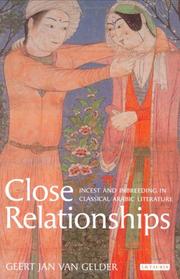
ISBN: 1850438552 9781850438557 Year: 2005 Publisher: London : I.B. Tauris & Co.,
Abstract | Keywords | Export | Availability | Bookmark
 Loading...
Loading...Choose an application
- Reference Manager
- EndNote
- RefWorks (Direct export to RefWorks)
This is a groundbreaking and comprehensive study of the diverse facts and opinions concerning incest and close-kin marriage found in literary and non-literary pre-modern Arabic texts. Incest is a motif found in lampoons, anecdotes, stories, legends, dream interpretation, and polemics with other religions, in particular the Zoroastrians, who in pre-Islamic times allegedly recommended next-of-kin marriage. Many of the relevant passages are presented as English translations in this richly documented book that will be of interest to philologists and students of Arabic literature or Islamic culture.
Arabic literature --- Incest in literature. --- History and criticism.
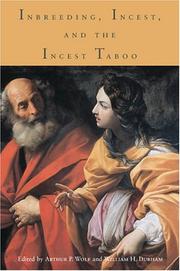
ISBN: 0804767416 142371654X 9781423716549 9780804767415 080474596X 9780804745963 0804751412 9780804751414 Year: 2005 Publisher: Stanford, Calif. : Stanford University Press,
Abstract | Keywords | Export | Availability | Bookmark
 Loading...
Loading...Choose an application
- Reference Manager
- EndNote
- RefWorks (Direct export to RefWorks)
Is inbreeding harmful? Are human beings and other primates naturally inclined to mate with their closest relatives? Why is incest widely prohibited? Why does the scope of the prohibition vary from society to society? Why does incest occur despite the prohibition? What are the consequences? After one hundred years of intense argument, a broad consensus has emerged on the first two questions, but the debate over the others continues. That there is a biological basis for the avoidance of inbreeding seems incontrovertible, but just how injurious inbreeding really is for successive generations remains an open question. Nor has there been any conclusion to the debate over Freud’s view that the incest taboo is necessary because humans are sexually attracted to their closest relatives—a claim countered by Westermarck's argument for the sexually inhibiting effects of early childhood association. This book brings together contributions from the fields of genetics, behavioral biology, primatology, biological and social anthropology, philosophy, and psychiatry which reexamine these questions.
Incest. --- Consanguinity. --- Inbreeding. --- Taboo. --- Purity, Ritual --- Religion --- Sacrilege --- Breeding --- Consanguinity --- Marriage --- Heredity --- Inbreeding --- Incest --- Kinship --- Sex crimes --- Sexual intercourse --- Prohibited degrees --- Taboo
Book
ISBN: 2704810052 Year: 2005 Publisher: Paris France-Empire
Abstract | Keywords | Export | Availability | Bookmark
 Loading...
Loading...Choose an application
- Reference Manager
- EndNote
- RefWorks (Direct export to RefWorks)
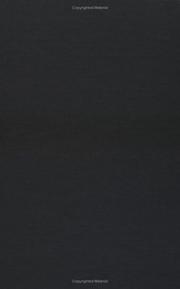
ISBN: 081223863X 0812219058 9786613212023 1283212021 0812203305 Year: 2005 Publisher: Philadelphia University of Pennsylvania Press
Abstract | Keywords | Export | Availability | Bookmark
 Loading...
Loading...Choose an application
- Reference Manager
- EndNote
- RefWorks (Direct export to RefWorks)
Maureen Quilligan explores the remarkable presence in the Renaissance of what she calls "incest schemes" in the books of a small number of influential women who claimed an active female authority by writing in high canonical genres and who, even more transgressively for the time, sought publication in print.It is no accident for Quilligan that the first printed work of Elizabeth I was a translation done at age eleven of a poem by Marguerite de Navarre, in which the notion of "holy" incest is the prevailing trope. Nor is it coincidental that Mary Wroth, author of the first sonnet cycle and prose romance by a woman printed in English, described in these an endogamous, if not legally incestuous, illegitimate relationship with her first cousin. Sir Philip Sidney and his sister, the Countess of Pembroke, translated the psalms together, and after his death she finished his work by revising it for publication; the two were the subject of rumors of incest. Isabella Whitney cast one of her most important long poems as a fictive legacy to her brother, arguably because such a relationship resonated with the power of endogamous female agency. Elizabeth Carey's closet drama about Mariam, the wife of Herod, spends important energy on the tie between sister and brother. Quilligan also reads male-authored meditations on the relationship between incest and female agency and sees a far different Cordelia, Britomart, and Eve from what traditional scholarship has heretofore envisioned.Incest and Agency in Elizabeth's England makes a signal contribution to the conversation about female agency in the early modern period. While contemporary anthropological theory deeply informs her understanding of why some Renaissance women writers wrote as they did, Quilligan offers an important corrective to modern theorizing that is grounded in the historical texts themselves.
Incest in de literatuur --- Incest in literature --- Inceste dans la littérature --- English literature --- Feminism and literature --- Incest in literature. --- Women and literature --- History and criticism. --- History --- Early modern, 1500-1700 --- History and criticism --- England --- 16th century --- LITERARY CRITICISM --- Women Authors --- English --- Languages & Literatures --- English Literature --- Literature --- British literature --- Inklings (Group of writers) --- Nonsense Club (Group of writers) --- Order of the Fancy (Group of writers) --- Women authors --- Literature and feminism --- Gender Studies. --- Literature. --- Medieval and Renaissance Studies. --- Women's Studies.
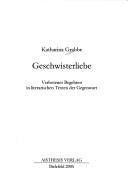
ISBN: 3895284963 9783895284960 Year: 2005 Publisher: Bielefeld : Aisthesis,
Abstract | Keywords | Export | Availability | Bookmark
 Loading...
Loading...Choose an application
- Reference Manager
- EndNote
- RefWorks (Direct export to RefWorks)
Geschwisterliebe und der mit dem erotischen Begehren zwischen Bruder und Schwester verbundene Tabubruch ist einer der Liebestopoi der Literaturgeschichte. Katharina Grabbe analysiert das Thema vor dem Hintergrund der Lacanschen Psychoanalyse und der aktuellen sich von Judith Butler herschreibenden Gender-Debatte am Beispiel dreier Romane der Gegenwartsliteratur: Pascal Merciers Der Klavierstimmer (1998), Marlene Streeruwitz’ Partygirl. (2002) und Jeffrey Eugenides’ Middlesex (2002, dt. 2003). Die der literarischen Geschwisterliebe eingeschriebene Ambivalenz von Verbot und Begehren wird auf den Bedeutungszusammenhang von symbolischer Ordnung und Inzestverbot zurückgeführt. Da die symbolische Ordnung an die Einsetzung der Sprache als Signifikationsmedium und damit an das Inzestverbot gebunden ist, stellt die literarische Geschwisterliebe immer auch das Funktionieren von Ordnungs- und Identitätsmodellen in Rede.
German fiction --- Incest in literature. --- History and criticism. --- Mercier, Pascal. --- Streeruwitz, Marlene. --- Eugenides, Jeffrey. --- Inceste --- Littérature allemande --- Dans la littérature --- 1990-.... --- Thèmes, motifs
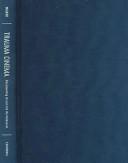
ISBN: 0520241746 0520241754 Year: 2005 Publisher: Berkeley (Calif.) : University of California press,
Abstract | Keywords | Export | Availability | Bookmark
 Loading...
Loading...Choose an application
- Reference Manager
- EndNote
- RefWorks (Direct export to RefWorks)
'Trauma Cinema 'focuses on a new breed of documentary films and videos that adopt catastrophe as their subject matter and trauma as their aesthetic. Incorporating oral testimony, home-movie footage, and documentary reenactment, these documentaries express the havoc trauma wreaks on history and memory. Janet Walker uses incest and the Holocaust as a double thematic focus and fiction films as a point of comparison. Her astute and original examination considers the Hollywood classic 'Kings Row 'and the television movie 'Sybil 'in relation to vanguard nonfiction works, including Errol Morris's 'Mr. Death, 'Lynn Hershman's video diaries, and the chilling genealogy of incest, 'Just, Melvin. ' Both incest and the Holocaust have also been featured in contemporary psychological literature on trauma and memory. The author employs theories of post traumatic stress disorder and histories of the so-called memory wars to illuminate the amnesias, fantasies, and mistakes in memory that must be taken into account, along with corroborated evidence, if we are to understand how personal and public historical meaning is made. Janet Walker's engrossing narrative demonstrates that the past does not come down to us purely and simply through eyewitness accounts and tangible artifacts. Her incisive analysis exposes the frailty of memory in the face of disquieting events while her joint consideration of trauma cinema and psychological theorizing radically reconstructs the roadblocks at the intersection of catastrophe, memory, and historical representation.
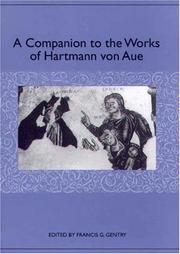
ISBN: 1571132384 157113641X Year: 2005 Publisher: Rochester (N.Y.) : Camden House,
Abstract | Keywords | Export | Availability | Bookmark
 Loading...
Loading...Choose an application
- Reference Manager
- EndNote
- RefWorks (Direct export to RefWorks)
In perhaps 25 years of creative productivity (ca. 1180-ca. 1205), Hartmann von Aue authored a dispute about love between the body and the heart, Die Klage, numerous songs of courtly love, crusading songs, and most likely took part in a Crusade himself. He composed the first German Arthurian romance, Erec, based on Chrétien's like-named work, and he -- apparently -- ended his literarycareer with a second, Iwein. Further, he is the creator of two provocative rel-igious-didactic works, Gregorius, a tale of double incest, repentance, and redemption, and Der arme Heinrich, the account of a seemingly perfect nobleman who is stricken with leprosy and then ultimately cured by a process set into motion by a very young peasant girl, whom he ultimately marries. Noother medieval German poet treats such an extraordinary breadth of themes at such a high level of artistic expression. The essays in this volume, written by scholars from North America and Europe, offer insight into many aspects of Hartmann's oeuvre, including the medieval and modern visual and literary reception of his works. The volume also offers considerations of Hartmann and Chrétien;Hartmann's putative theological background and the influence of the Bible on his tales; the reflection of his medical knowledge in Der arme Heinrich and Iwein; and a complete survey of his lyric production. Newer avenues of research are also presented, with essays on issues of gender and on the role of pain as a constitutive part of the courtly experience. It is hoped that this volume will prove to be a stimulating companion not only for those familiar with Hartmann but also for those who are just making the acquaintance of one of the greatest of medieval German poets.
Francis G. Gentry is Professor Emeritus of German at the Pennsylvania State University and the University of Wisconsin-Madison.
Hartmann, --- Criticism and interpretation. --- Aue, Hartmann von, --- Hartman, --- Hartmann von Aue, --- Hartman von Owe --- LITERARY CRITICISM / European / General. --- Arthurian romance. --- Der arme Heinrich. --- Die Klage. --- Gregorius. --- Hartmann von Aue. --- body. --- courtly experience. --- courtly love. --- crusading songs. --- double incest. --- gender. --- heart. --- leprosy. --- love. --- medieval German poet. --- nobleman. --- pain. --- redemption. --- repentance.
| Listing 1 - 10 of 12 | << page >> |
Sort by
|

 Search
Search Feedback
Feedback About UniCat
About UniCat  Help
Help News
News